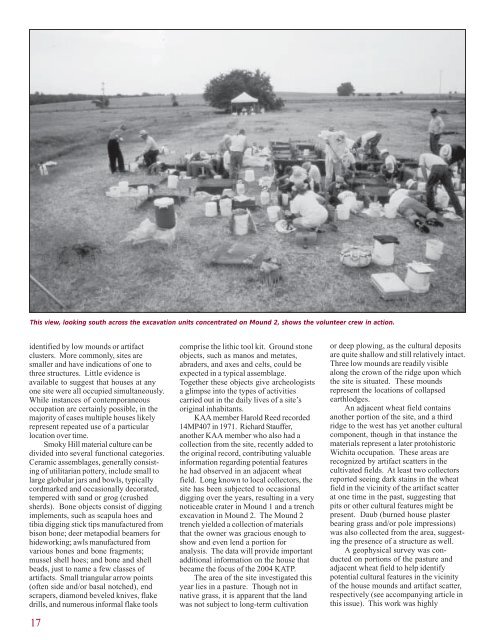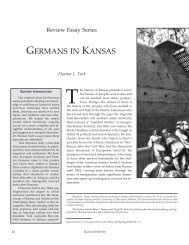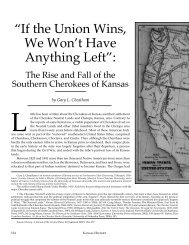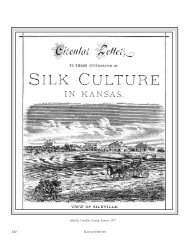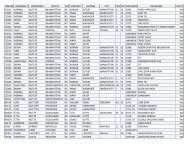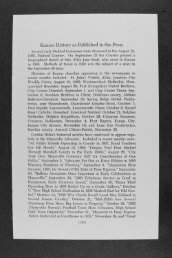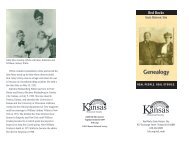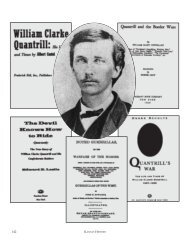July/August 2004 - Kansas Historical Society
July/August 2004 - Kansas Historical Society
July/August 2004 - Kansas Historical Society
Create successful ePaper yourself
Turn your PDF publications into a flip-book with our unique Google optimized e-Paper software.
This view, looking south across the excavation units concentrated on Mound 2, shows the volunteer crew in action.<br />
identified by low mounds or artifact<br />
clusters. More commonly, sites are<br />
smaller and have indications of one to<br />
three structures. Little evidence is<br />
available to suggest that houses at any<br />
one site were all occupied simultaneously.<br />
While instances of contemporaneous<br />
occupation are certainly possible, in the<br />
majority of cases multiple houses likely<br />
represent repeated use of a particular<br />
location over time.<br />
Smoky Hill material culture can be<br />
divided into several functional categories.<br />
Ceramic assemblages, generally consisting<br />
of utilitarian pottery, include small to<br />
large globular jars and bowls, typically<br />
cordmarked and occasionally decorated,<br />
tempered with sand or grog (crushed<br />
sherds). Bone objects consist of digging<br />
implements, such as scapula hoes and<br />
tibia digging stick tips manufactured from<br />
bison bone; deer metapodial beamers for<br />
hideworking; awls manufactured from<br />
various bones and bone fragments;<br />
mussel shell hoes; and bone and shell<br />
beads, just to name a few classes of<br />
artifacts. Small triangular arrow points<br />
(often side and/or basal notched), end<br />
scrapers, diamond beveled knives, flake<br />
drills, and numerous informal flake tools<br />
17<br />
comprise the lithic tool kit. Ground stone<br />
objects, such as manos and metates,<br />
abraders, and axes and celts, could be<br />
expected in a typical assemblage.<br />
Together these objects give archeologists<br />
a glimpse into the types of activities<br />
carried out in the daily lives of a site’s<br />
original inhabitants.<br />
KAA member Harold Reed recorded<br />
14MP407 in 1971. Richard Stauffer,<br />
another KAA member who also had a<br />
collection from the site, recently added to<br />
the original record, contributing valuable<br />
information regarding potential features<br />
he had observed in an adjacent wheat<br />
field. Long known to local collectors, the<br />
site has been subjected to occasional<br />
digging over the years, resulting in a very<br />
noticeable crater in Mound 1 and a trench<br />
excavation in Mound 2. The Mound 2<br />
trench yielded a collection of materials<br />
that the owner was gracious enough to<br />
show and even lend a portion for<br />
analysis. The data will provide important<br />
additional information on the house that<br />
became the focus of the <strong>2004</strong> KATP.<br />
The area of the site investigated this<br />
year lies in a pasture. Though not in<br />
native grass, it is apparent that the land<br />
was not subject to long-term cultivation<br />
or deep plowing, as the cultural deposits<br />
are quite shallow and still relatively intact.<br />
Three low mounds are readily visible<br />
along the crown of the ridge upon which<br />
the site is situated. These mounds<br />
represent the locations of collapsed<br />
earthlodges.<br />
An adjacent wheat field contains<br />
another portion of the site, and a third<br />
ridge to the west has yet another cultural<br />
component, though in that instance the<br />
materials represent a later protohistoric<br />
Wichita occupation. These areas are<br />
recognized by artifact scatters in the<br />
cultivated fields. At least two collectors<br />
reported seeing dark stains in the wheat<br />
field in the vicinity of the artifact scatter<br />
at one time in the past, suggesting that<br />
pits or other cultural features might be<br />
present. Daub (burned house plaster<br />
bearing grass and/or pole impressions)<br />
was also collected from the area, suggesting<br />
the presence of a structure as well.<br />
A geophysical survey was conducted<br />
on portions of the pasture and<br />
adjacent wheat field to help identify<br />
potential cultural features in the vicinity<br />
of the house mounds and artifact scatter,<br />
respectively (see accompanying article in<br />
this issue). This work was highly


